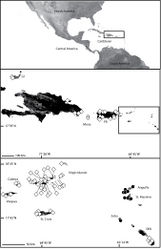Selenops amona
| Notice: | This page is derived from the original publication listed below, whose author(s) should always be credited. Further contributors may edit and improve the content of this page and, consequently, need to be credited as well (see page history). Any assessment of factual correctness requires a careful review of the original article as well as of subsequent contributions.
If you are uncertain whether your planned contribution is correct or not, we suggest that you use the associated discussion page instead of editing the page directly. This page should be cited as follows (rationale):
Citation formats to copy and paste
BibTeX: @article{Crews2011ZooKeys105, RIS/ Endnote: TY - JOUR Wikipedia/ Citizendium: <ref name="Crews2011ZooKeys105">{{Citation See also the citation download page at the journal. |
Ordo: Araneae
Familia: Selenopidae
Genus: Selenops
Name
Selenops amona Crews, 2011 sp. n. – Wikispecies link – ZooBank link – Pensoft Profile
Type material
Holotype female: Bajura Empalme, Isla Mona, I.2007, A. Puente-Rolón (EME sel_847).
Other material examined
PUERTO RICO: Isla Mona: same data as holotype, 1 imm. (EME sel_846); Camino de los Cobros, VI.2006, A. Puente-Rolón, SCC06_059, under bark of Bursera, 1 imm. (CAS sel_502); Maricao: Bosque Estatl de Maricao, 18°08'51.2"N, 66°59'35.0"W, 10.VI.2006, 700–800 m, S. Crews, A. Puente- Rolón, serpentine forest, 1 imm. (CAS sel_440).
Etymology
The specific name comes from the Taino word ‘amona', the indigenous name for the type locality. It is to be treated as a noun in apposition.
Diagnosis
Females can be separated from other species by the extensively coiled internal ducts (Figs 87–88). Males unknown.
Description
Holotype female: Color: carapace light tan-yellow, slightly darker in cephalic region, dusky around edges; sternum pale yellow; chelicerae light yellowish-tan, dusky markings anteromedially, progressively becoming darker to black at the distal end of the chelicerae; maxillae pale yellow; labium pale yellow; abdomen dorsally yellowish-orange, dark on sides, with laterocaudal festoon; lanceolate stripe located medially extending about half the length of the abdomen, faded spot anteriorly, 2 more spots just below, 2 more below that, and 3 spots at posterior margin of abdomen; ventrally cream-colored laterocaudally; legs pale yellow, darkening distally, annulations present. Carapace: 0.89 times longer than broad; fovea longitudinal, broad, very shallow. Eyes:AER nearly straight; PER slightly recurved; PME larger than AME, PME same as PLE, ALE smallest; eye diameters, AME 0.10, ALE 0.08, PME 0.25, PLE 0.25; interdistances AME-PME 0.03, PME-ALE 0.15, ALE-PLE 0.23. PME-PME 0.98. ALE-ALE 1.68; ocular quadrangle AME-AME 0.30, PLE-PLE 1.70; clypeus 0.08 high. Mouthparts:chelicerae with stout setae medially and anteriorly; maxillae longer than broad, with tuft of conspicuous setae distally; labium distally rounded. Sternum: 1.14 times longer than broad, posteriorly indented. Legs:leg I only slightly shorter than legs II, III and IV; leg formula unknown (at least one leg missing); legs II and III equal in length, with I just slightly shorter; scopulae present on all 4 tarsi and metatarsi and tibia I and II; tarsi I-IV with strong claw tufts; pr claw per foot slightly toothed; spination: leg I, Fm pr 1–1–1, d 1–1–1, rl 1–1–1; Ti d 0, v 2–2–2; Mt v 2–2; leg II, Fm pr 1–1–0, d 1–1–1, rl 1–0–1; Ti v 2–2–2; Mt v 2–2; leg III, Fm pr 1–1–1, d 1–1–1, rl 1–1–1; Ti v 2–2–0; Mt v 2–1. Abdomen:with terminal setal tufts. Pedipalp:claw with 5 teeth. Epigyne:lateral lobes fused medially for nearly 2/3 the length of the plate, small v-shaped medial area located anteriorly, genital openings located at lateral margins of v-shape, epigynal pockets absent; internally, wide ducts coiled multiple times, mostly symmetrical, though not exactly, large posterodorsal fold, covering a large part of the internal ducts (Figs 87–88). Dimensions: Total length 6.33. Carapace length 3.00, width 3.38. Sternum length 1.60, width 1.40. Abdomen length 3.33, width 2.48. Pedipalp: Fm 1.00, Pt 0.25, Ti 0.50, Ta 0.80, total 2.55. Leg I: Fm 3.50, Pt 1.00, Ti 3.50, Mt 2.25, Ta 1.00, total 11.25. Leg II: Fm 3.50, Pt 1.00, Ti 3.50, Mt 2.50, Ta 1.00, total 11.50. Leg III: Fm 3.75, Pt 1.00, Ti 3.00, Mt 2.75, Ta 1.00, total 11.50. Leg IV: Missing.
Natural history
Found under bark and rocks.
Distribution
Known from Isla Mona and a single locality in western Puerto Rico (Map 9).
Original Description
- Crews, S; 2011: A revision of the spider genus Selenops Latreille, 1819 (Arachnida, Araneae, Selenopidae) in North America, Central America and the Caribbean ZooKeys, 105: 1-182. doi
Images
|

